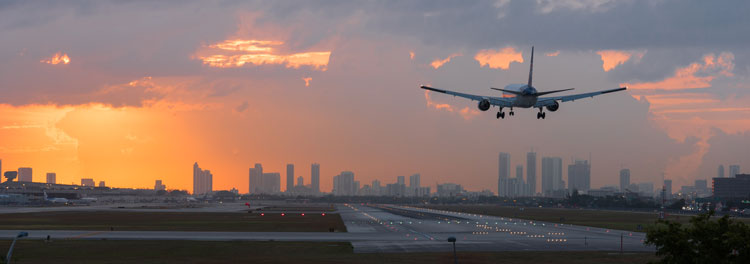Investing in airport technology services is central to Miami’s vision
Posted: 22 April 2020 | Maurice Jenkins, Tara Nolan (International Airport Review) | No comments yet
Tara Nolan spoke to the renowned Maurice Jenkins to learn of his opinions on how airport IT should be furthered leveraged across the industry, and how technology sits in the centre of Miami Airport’s vision.


Looking at the airport IT sector across the globe, is there a technology implementation that surprises you? Are there airports utilising IT in ways no one else is?
Certainly, in this new paradigm that we are experiencing, I am not surprised to see the rapid re-positioning of biometrics and the frictionless seamless travel experience to now include an emphasis on contactless and touchless. I think that resonates, and will continue to resonate, with the travelling public for some time.


Additionally, the solution includes a camera which can be used to read the passport data from a distance. This seems like a great solution to reduce the need for a traveller to lay his or her passport on the kiosk during the check-in process, however, it overlooks one of the important security measures that this process provides: Fraud detection. To verify passport authenticity, an RFID reader is built into the kiosk for verification of the e-chip data, embedded in the passport, that allows for a higher level of assurance that the passport is authentic. Coupled with the normal APIS or Secure-Flight checks, when this is used in a biometric-enabled solution, the digitised image can then be cross-matched against a live image capture to provide a higher level of trusted identity verification without introducing unintended security risks.
I have no doubt we’ll continue to see accelerated entries into the market, so due diligence will be critical in ensuring new vulnerabilities and security risks that lead to bigger issues are not introduced.
At 2019’s Airport IT & Security, Maurice Jenkins was Chair for the IT stream. Once again, at this year’s Airport IT & Security conference, Maurice will share his advice and opinions on all the hot topics within airport IT.
What are the biggest discrepancies regarding the use of IT in small airports in comparison to large-sized hubs? Is this an issue – should there be continuity across airports to ensure the passenger experience is seamless?
Historically many of the small airports have struggled to access the same funding or budgets as large airports, since access to federal funds is often directly related to the prior years’ passenger volumes and revenues. This continues to perpetuate a disparity that becomes harder and harder to overcome. In 2019’s Airport Improvement Program, there was an effort made to focus larger contributions to smaller, non-hub airports to help correct that situation. As a result, you’re seeing new airports undertake new construction programmes that will drive those changes.
The travelling public wants continuity of experience. Many people only travel once per year, so having to learn a different process or have a different experience at each airline or airport causes stress and confusion; requiring higher staffing levels to support, educate and continually re-train the public. To make it easy for the industry, we should all seek to standardise passenger experience as much as possible to create a seamless experience that’s consistent in all aspects.
With growing threats on cyber-security and digital hackers, how can we best safeguard the future of airport IT?
Cyber-security practices and technical due diligence need to be at the heart of airport IT security policies and practices. As more and more of us move to adopt cloud-based infrastructure, IoT and smart-airport devices and capabilities, and a more digital, interactive approach to customer engagement, we need to be conscious of the responsibilities in safeguarding and protecting our customers and our infrastructure from vulnerabilities.
Don’t miss Maurice Jenkin’s presentation at Airport IT & Security 2020. Over 400 individuals from 100 unique airports will gather to network, share best practices and discuss the future of airport IT.
When considering new technologies, partners or engaging with start-ups, it’s important to think about mitigation strategies as well as core non-functional requirements such as resiliency, reliability, scalability, stability and all of the things that help create a world-class, ‘always-on’ system that can serve customers’ needs without introducing weaknesses that would leave us vulnerable to outages or issues that would impact operations. Airports should be working with our industry partners and associations like ACI World to leverage support and best practices.
At this moment in time, what is the technology that Miami International Airport relies on the most? Do you see this changing in the coming years?
Miami Dade International Airport is the gateway to the world, serving more than 100 airlines and offering more flights to the Caribbean and Latin America than any other airport in the U.S. Our goal is to make Miami the global airport of choice with a world-class experience.
I welcome any insight as we work to deliver IT best practices for our system of airports
Central to our vision is investing in technology services that can be shared across all airlines and services via our core common-use technology platform as the optimum way to ensure continuity of the experience throughout the airport, and make the widest array of services available to all of our airline partners. We see this being one of the core technologies we rely upon most, as it offers a great way for us to maximise our ability to deliver the latest in technology innovation to our airlines, in the most efficient way possible.
In 2020, we continue to focus on that, as well as the exploration of technologies that support our vision and growth objectives. Obviously, COVID-19 will have an influence on how we prioritise new innovations, that could include thermal-sensing and an even greater focus on biometrics with the ability to offer touchless and contactless solutions.


Regarding the COVID-19 pandemic, could airports have used technology better to protect themselves?
This isn’t the first time that the industry has faced a health-related crisis: SARS, Ebola, H1N1; but none of those have been at the magnitude or scale that we’re facing today. Each year we see the industry impacted by natural events like hurricanes, tornados, fires or earthquakes. In this case, I think we all hoped for containment strategies or measures to be available more quickly, which would have allowed us to return to some level of predictable operations and without the tragic loss of life or economic woes that we’re now seeing and experiencing.
With new speakers announced frequently – who will join Maurice in Munich in October 2020 – the agenda for Airport IT & Security is worth a look. Reserve your ticket now to ensure you don’t miss out on this unique networking experience.
Could technology have helped? Maybe. Many processes are still paper-based or high-touch which we can clearly see contribute to the spread of germs and bacteria as well as viruses. That will remain a problem until regulation is changed to allow solutions like e-Gates and biometrics, similar to trials other airports have engaged in and what we have engaged in with SITA and Smart Path. Deployable from a ticket counter to the TSA checkpoint or in the U.S. Arrivals hall in lieu of an officer having to collect and touch your boarding pass and/or passport.
Certain measures could certainly be taken, but many are much more dependent on regulation.
What areas of airport IT do you believe need to be discussed and explored further?
As part of our Miami International Airport app, we offer a mobile passport control solution, in collaboration with U.S. Customs and Border Protection (CBP), that allows travellers to submit their customs declaration forms in advance of arrival to the U.S. Our solution, developed with one of our business partners, SITA, allows these forms to be easily configurable and customisable to create additional questions that might aid in vetting travellers before their arrival to the U.S. from visiting countries – for example, “Have you been to any of the following countries…?”. This is worthy of additional dialog with one of our most engaged business partners, CBP. If we want to look at how we collectively act more quickly in response to pandemics like this in the future, we need a more dynamic way of adapting our operations, implementing new technology and collaborating to introduce this type of ability more readily.
When the market rebounds, we’ll undoubtedly see a resurgence first for U.S. domestic travel with a slower rise in international travel. We need to be sure that we have solutions ready that can serve the domestic customer-base and are not exclusive to our international customers. Bringing the touchless, contactless realm to the domestic terminals is one of those areas that is important to our strategy and will likely require regulatory focus and collaboration with TSA, Congress and our industry organisations to drive the change that will enable technology solutions, like our SITA Smart Path implementation, to move beyond U.S. Exit and be made available to the domestic population; allowing us to protect our TSA officers from having to physically touch and review traveller documents.
Many systems are accessible only while on-site due to the sensitive nature of the data, which limits the ability to offer remote-working solutions that can protect staff. We’re looking at how common-use solutions like SITA’s Airport Connect FLEX could offer support for a BYOD (bring your own device) model and remote connectivity to authorised staff and devices, which can minimise the use of shared devices and workstations. If there are additional providers offering similar technologies, it is incumbent on them to introduce to airports or via industry. As the current chairman of ACI – World IT Committee, I welcome any insight as we work to deliver IT best practices for our system of airports.
Related topics
Airport development, Big data, Biometrics, Contactless / Touchless technology, Funding and finance, Information technology (IT), Passenger experience and seamless travel, Terminal operations


















